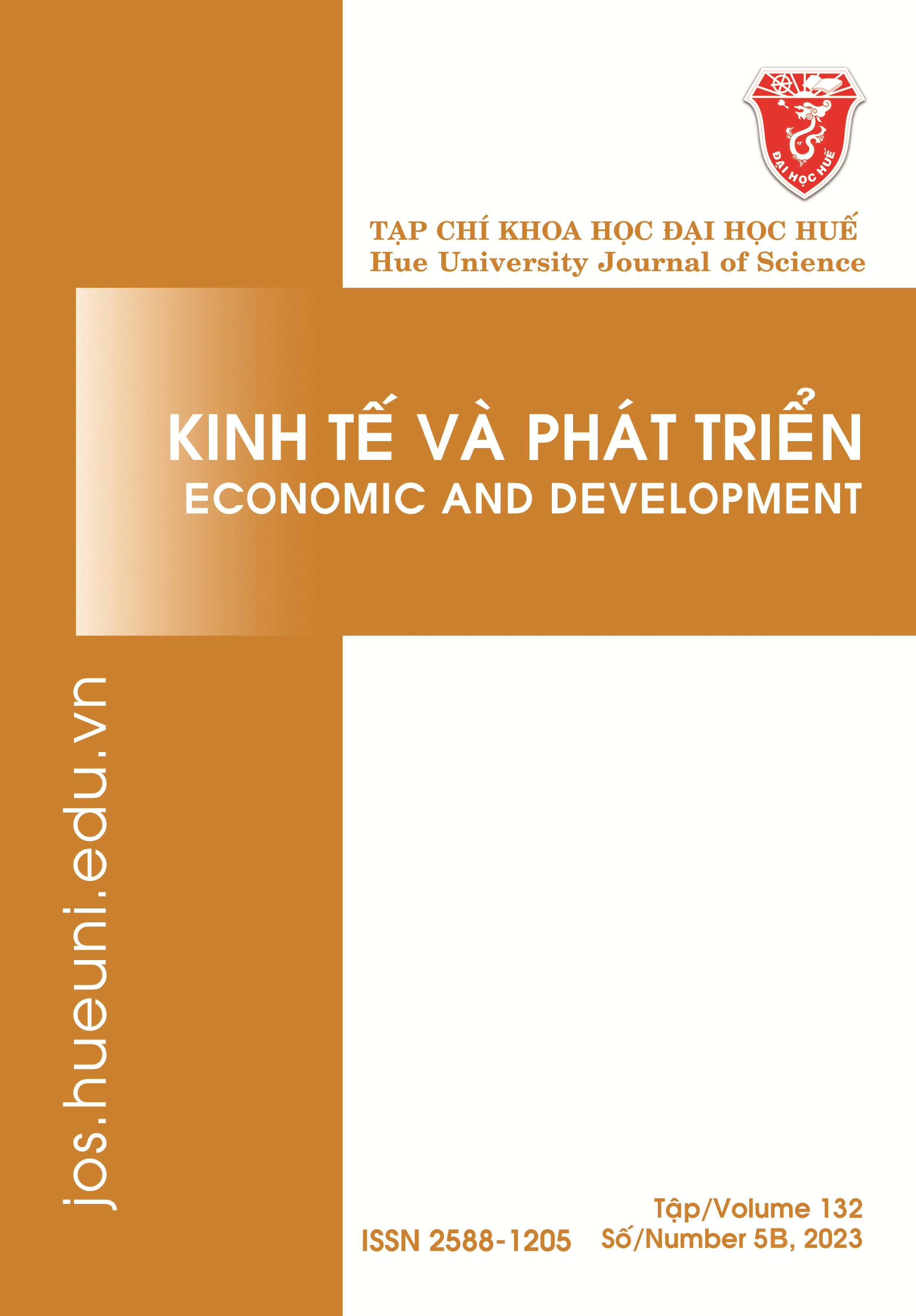Abstract
This study aims to evaluate the factors affecting voluntary social insurance participation of small traders. The proposed research model was based on merging Theory of Planned behavior (TPB) and Technology acceptance model (TAM) to examine how to form the participating voluntary social insurance intentions. The research sample was taken from 322 people who are small traders in Ho Chi Minh City. The results of data analysis (CB-SEM technique) show that attitude is an important factor affecting intention. Other factors in TAM and TPB also significantly influence voluntary social insurance participation intention. In the conclusion of this study, implications for voluntary social insurance policies were presented.
References
- Viet Nam Social Security (2019), Social Insurance and Health Insurance media for the sustainable development of social security policies, In Social Insurance Vietnam, https://baohiemxahoi.gov.vn/tintuc/Pages/an-sinh-xa-hoi.aspx?CateID=0&ItemID=12865&OtItem=date (in Vietnamese).
- Nhan Dan newspaper (2021), Opportunities for informal workers to access voluntary social insurance. https://nhandan.vn/bhxh-va-cuoc-song/co-hoi-tiep-can-cua-lao-dong-phi-chinh-thuc-voi-bao-hiem-xa-hoi-tu-nguyen-679206/.Mamun, A. Al., Rahman, M. K., Munikrishnan, U. T., & Permarupan, P. Y. (2021), Predicting the intention and purchase of health insurance among Malaysian working adults, SAGE Open, 11(4). https://doi.org/10.1177/21582440211061373 (in Vietnamese).
- Alfiero, S., Battisti, E., & Ηadjielias, E. (2022), Black box technology, usage-based insurance, and prediction of purchase behavior: Evidence from the auto insurance sector, Technological Forecasting and Social Change, 183, 121896. https://doi.org/10.1016/j.techfore.2022.121896.
- Liu, J., Lin, S., & Feng, Y. (2018), Understanding why Chinese contractors are not willing to purchase construction insurance, Engineering, Construction and Architectural Management, 25(2), 257–272. https://doi.org/10.1108/ECAM-08-2016-0186.
- Dung, N. T. N., & Sinh, N. T. (2019), Study on the factors affecting the participating intention of voluntary social insurance of employees in Thach That, Hanoi, Jounal of Science&Technology, 53, 107–112.
- Davis, F. D. (1989), Perceived usefulness, perceived ease of use, and user acceptance of information technology, MIS Quarterly, 13(3), 319–340. https://doi.org/10.1016/S0378-7206(01)00143-4.
- Ajzen, I. (1991), The theory of planned behavior, Organizational Behavior and Human Decision Processes, 50(2), 179–211.
- Choe, J. Y., Kim, J. J., & Hwang, J. (2021), Innovative marketing strategies for the successful construction of drone food delivery services: Merging TAM with TPB, Journal of Travel & Tourism Marketing, 38(1), 16–30.
- Teo, T. (2012), Examining the intention to use technology among pre-service teachers: An integration of the technology acceptance model and theory of planned behavior, Interactive Learning Environments, 20(1), 3–18.
- Davis, F. D. (1985), A technology acceptance model for empirically testing new end-user information systems: Theory and results, Massachusetts Institute of Technology.
- Nguyen Trong, H., Dang, T. V., Nguyen, V., & Nguyen, T. T. (2022), Determinants of e-government service adoption: an empirical study for business registration in Southeast Vietnam, Journal of Asian Public Policy, 15(3), 453–468. https://doi.org/10.1080/17516234.2020.1805396.
- The National Assembly (2014), Law on Social insurance, Retrieved 05/09/2022 from https://vss.gov.vn/english/legal/Pages/default.aspx?ItemID=3544.
- Viet Nam Social Security (2017), General introduction. In Viet Nam Social Security. https://baohiemxahoi.gov.vn/gioithieu/pages/gioi-thieu-chung.aspx?CateID=0&ItemID=8413.
- Raza, S. A., Ahmed, R., Ali, M., & Qureshi, M. A. (2019), Influential factors of Islamic insurance adoption: an extension of theory of planned behavior, Journal of Islamic Marketing, 11(6), 1497–1515. https://doi.org/10.1108/JIMA-03-2019-0047.
- Buabeng-Andoh, C. (2018), Predicting students’ intention to adopt mobile learning, Journal of Research in Innovative Teaching & Learning, 11(2), 178–191. https://doi.org/10.1108/jrit-03-2017-0004.
- Mailizar, M., Burg, D., & Maulina, S. (2021), Examining university students’ behavioural intention to use e-learning during the COVID-19 pandemic: An extended TAM model, Education and Information Technologies, 26(6), 7057–7077. https://doi.org/10.1007/s10639-021-10557-5.
- Asnakew, Z. S. (2020), Customers’ continuance intention to use mobile banking: Development and testing of an integrated model, The Review of Socionetwork Strategies, 14(1), 123–146. https://doi.org/10.1007/s12626-020-00060-7.
- Zheng, J., & Li, S. (2020), What drives students’ intention to use tablet computers: An extended technology acceptance model, International Journal of Educational Research, 102(November 2019), 101612. https://doi.org/10.1016/j.ijer.2020.101612.
- To, A. T., & Trinh, T. H. M. (2021), Understanding behavioral intention to use mobile wallets in Vietnam: Extending the tam model with trust and enjoyment, Cogent Business and Management, 8(1), https://doi.org/10.1080/23311975.2021.1891661.
- Wei, F., Feng, N., Xue, J., Zhao, R., & Yang, S. (2021), Exploring SMEs’ behavioral intentions of participating in platform-based innovation ecosystems, Industrial Management and Data Systems, 121(11), 2254–2275. https://doi.org/10.1108/IMDS-08-2020-0456.
- Podsakoff, P. M., MacKenzie, S. B., Lee, J. Y., & Podsakoff, N. P. (2003), Common method biases in behavioral research: A critical review of the literature and recommended remedies, Journal of Applied Psychology, 88(5), 879–903. https://doi.org/10.1037/0021-9010.88.5.879.
- Hair, J. F., Black, W. C., Babin, B. J., Anderson, R., & Tatham, R. L. (2014), Multivariate Data Analysis (7th ed.), Pearson.
- Hair, J. F., Jr, H., G. T. M., R., & Sarstedt, M. (2016), A primer on partial least squares structural equation modeling (PLS-SEM) (Sage Publi), Sage Publications.
- Fornell, C., & Larcker, D. F. (1981), Evaluating structural equation models with unobservable variables and measurement error, Journal of Marketing Research, 1(18), 39–50. https://doi.org/10.1177/002224378101800104.
- Henseler, J., Ringle, C. M., & Sarstedt, M. (2015), A new criterion for assessing discriminant validity in variance-based structural equation modeling, Journal of the Academy of Marketing Science, 43(1), 115–135.
- Hu, L., & Bentler, P. M. (1999), Cutoff criteria for fit indexes in covariance structure analysis: Conventional criteria versus new alternatives, Structural Equation Modeling: A Multidisciplinary Journal, 6(1), 1–55. https://doi.org/10.1080/10705519909540118.
- Kazaure, M. A. (2019), Extending the theory of planned behavior to explain the role of awareness in accepting Islamic health insurance (takaful) by microenterprises in northwestern Nigeria, J. Islam. Account. Bus. Res., 10(4), 607–620. https://doi.org/10.1108/JIABR-08-2017-0113.

This work is licensed under a Creative Commons Attribution-ShareAlike 4.0 International License.
Copyright (c) 2023 Array
